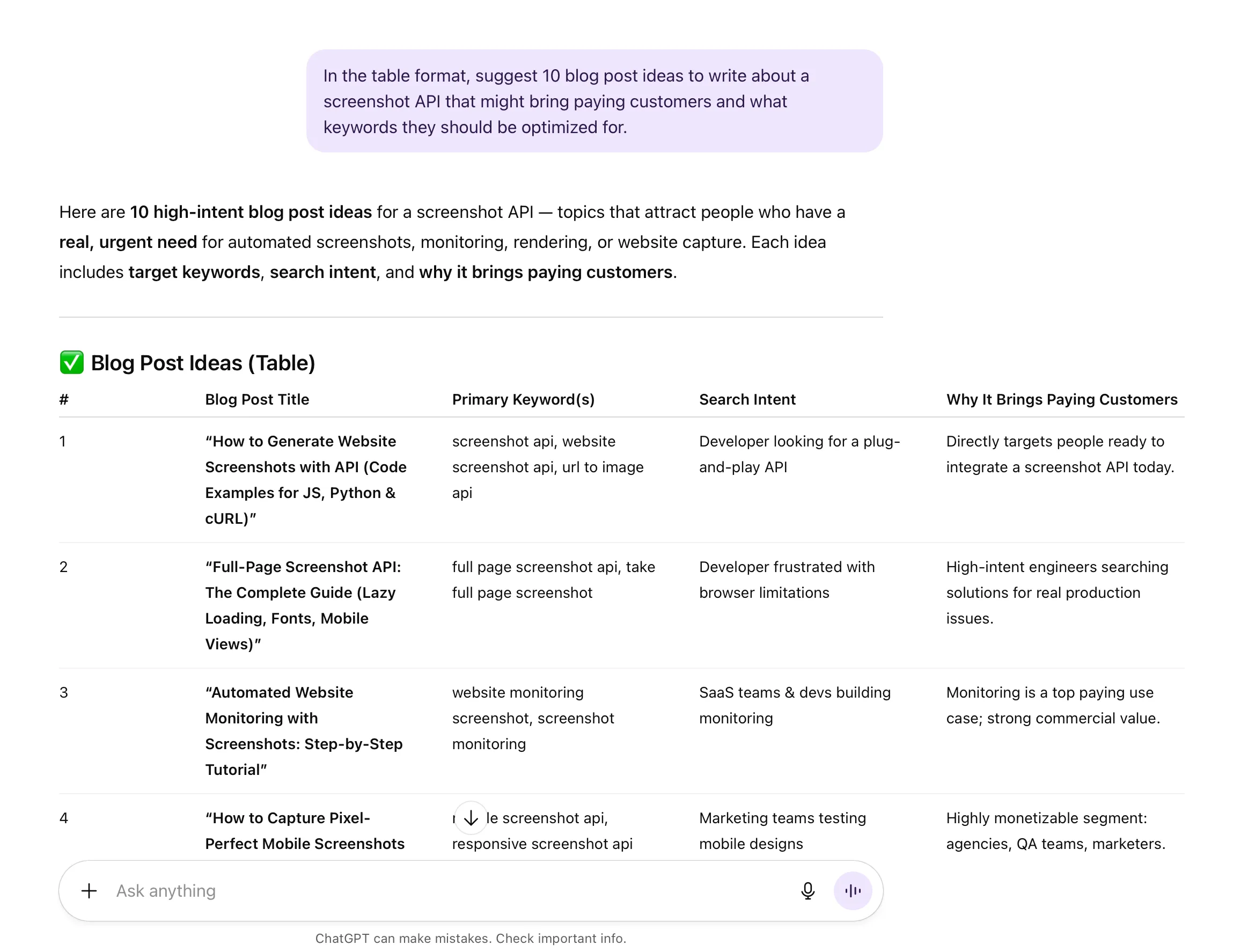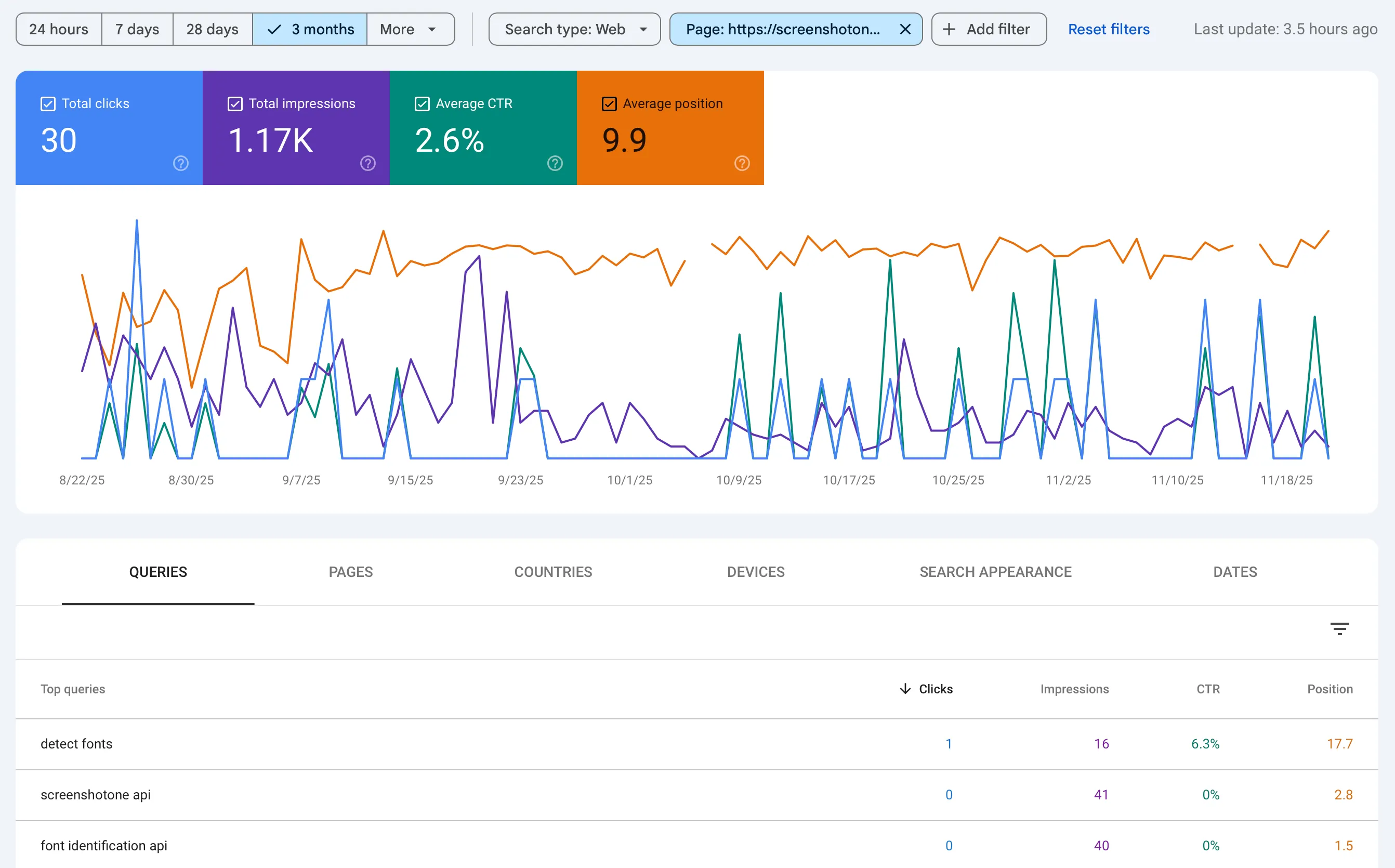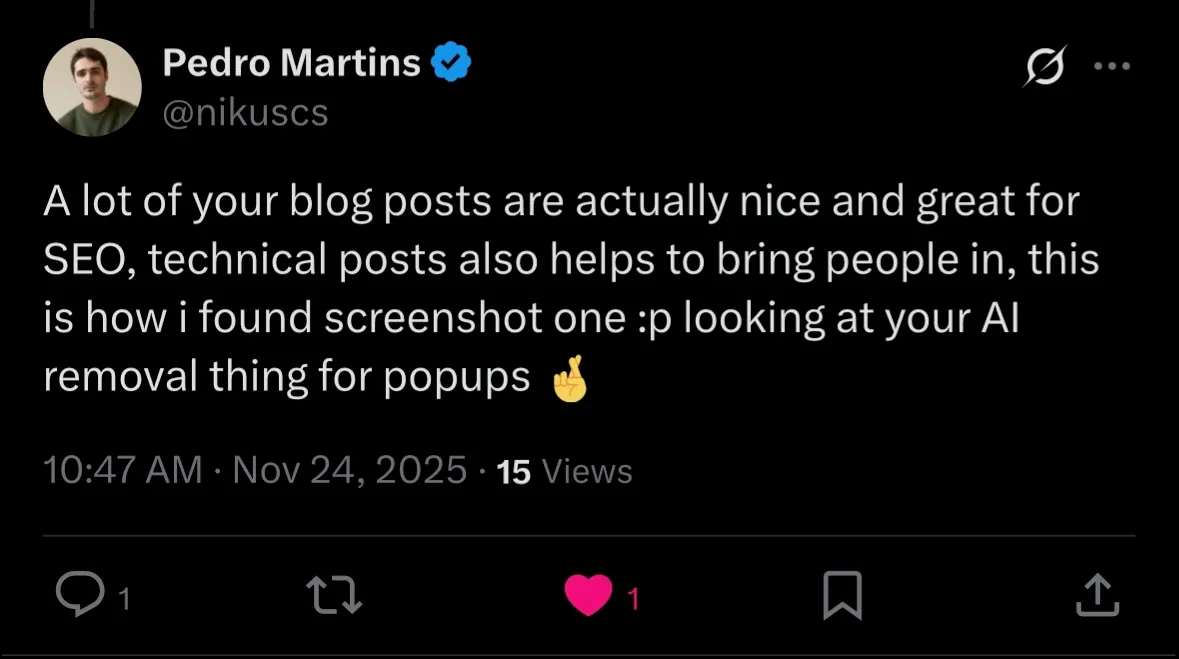Blog posts for SEO and AI that bring paying customers
SEO is a long-term strategy and it takes a lot of time to start ranking and then get to the top positions. You don’t want to invest your time into the blog posts that won’t rank well and where you have no chance to get to the first or at least third position.
People often share that they find my ScreenshotOne blog posts valuable:
I am incredibly grateful and lucky. But I do try to help people as much as possible and write the most valuable piece of content I can. I do that on purpose.
I truly believe that you must write that way and make sure that if people find your content, they don’t go back to the Google Search and can satisfy their search request. Share your best knowledge and try really to help people. That’s the only way to get real long-term pay off and maybe a few backlinks.
Brainstorm, evaluate and place bets
I don’t believe in building 12 products in 12 months, but SEO and AI optimization is a space where a similar strategy might work.
Invest in writing 10 blog posts in 4 weeks. But do not write random blog posts, otherwise it will be waste of time. Consider them as bets ranked by the change of the return on your investment.
Use AI for suggestions
First brain storm all possible ideas for your API product niche. I didn’t have ChatGPT when I launched my product, so my approach was to just share my journey and how I am building my screenshot API. It played out well for me, but you can shorten this time and use AI to help you. For example: “In the table format, suggest 10 blog post ideas to write about a screenshot API that might bring paying customers and what keywords they should be optimized for.”

It might be already a good enough hypothesis to start with.
Use Google Search for suggestions
Google has a brilliant feature that hints what people search for related to your niche. For example, for the “screenshot API” keyword:

Compared to AI, these are real keywords people search for and it is worth considering to write about them.
Use Bing for suggestions
In Bing there is a block “Deep dive into …” that you can also use as suggestions for your potential posts.

I assume it works similar to Google’s “People also search for” and based on the real
Competitors
You can consider using your competitor posts for inspiration and ideas on what to write about. Don’t copy anything though.
I didn’t use that approach, because I generally don’t believe in following competitors. You need to focus on your customers and build your position based on what they. You don’t know why your competitors do what they do and if that works for them. Also, if you are similar to your competitors, why will they choose you?
I did notice that competitors follow my blog posts and copy them or copy ideas from them, but there is nothing I can do about that except constantly improving my content and making it better and better.
Using Ahrefs and similar tools for evaluation
You can also use Ahrefs to collect ideas and search keywords you can optimize for. They also have a high quality and really helpful post on how to blog.
The post itself is a good example on how to write blog posts.
I find tools like that especially useful, once you collected all your hypothesis and you check if they have any real traffic. You don’t want to write blog posts that won’t get any traffic. However, if you have a strong feeling that your post might work and there is no data to back up your decision, you can try that. You will later see and build your all intuition on how good are these tools on evaluating traffic.
Consider if AI can already answer
If AI can already answer the question you are writing about in your blog post, is it still worth writing?
I believe yes, because:
- AI still can search the Internet to answer that question to answer the prompt.
- You share from your experience and from your point of view. It is more valuable than an average Internet answer.
- People still use Google Search and Bing. However, Google has AI overviews, but your post can be ranked.
Write and publish
Once you identified blog posts you are going to write. Write and publish them. Submit them to Google Search Console for indexing and wait.
I do not recommend to use AI for writing your blog posts. Unless you can write a really helpful high quality post that works. But I haven’t seen that somebody writes incredibly well with AI in practice, even once.
I would use AI to check facts and get opinions on if everything in the blog post can be improved, but not to write it completely for you.
As much as you can try to write from your personal perspective. It is one of the few ways to really differentiate your content, secondly it is valuable for Google and AI to have a personal position on the topic, especially if you might be considered an expert in your niche.
Link to it and promote the blog post
Internally put as many links as possible in the relevant context to your new blog post. Both for search and AI, and for people who might navigate and check out the post.
Share your blog post on social media and other platforms. Consider cross-posting to Medium and similar resources, but do not forget to set the canonical URL to your original blog post.
Backlinks
The same as you try to promote your main landing page with backlinks and rank it higher. It works the same way with your blog posts.
One of the best ways to get high quality backlinks for your technical (and not only) blog posts is reach out to people who own technical blog posts and ask for writing a blog post on exchange for the backlink.
Services like Help a B2B Writer can also be helpful. You get a request to share your expertise in exchange for the backlink. And you specifically target your blog posts or even write new ones to satisfy the request.
Wait and collect data
Once published and indexed, and you promoted the post. You need to wait and collect data:
- Impressions in search.
- Visits to the posts.
- Conversions/subscriptions/paying customers.
You will need all that data to make decisions and what to improve and how. And what to post more about.
Use ads to boost posts and learn faster
If waiting is not an option, you can consider buying paid ads, but specifically for your blog posts to see if people click on them and these posts bring conversions.
It might bring you first results much faster but it will cost you money.
Analyze, improve and write more
Check search data and improve your posts
Once you get the first impressions for your posts and can check for keywords in Google Search Console:

For my ScreenshotOne post on how to detect fonts with my API, I get keywords: “detect fonts”, “font detection API” and so on.
Now, I can decide if I want to create more posts and describe on how to detect fonts, or if I want a separate endpoint or even an API for font detection and so on.
Once I have real data, I can see how I can improve these posts.
Check what posts convert and write more like these
If you haven’t set up a product analytics for your API product, there is no way you can advance with SEO and AI to see what bets are paying off and what not.
I use PostHog, I consider it a collection of developer tools for product engineers. It has a lot of features and affordable pricing. But you might use any similar tool.
I can query it to see what posts brought real paying customers from Google:

Once I know what posts work, I can make more of them and I need to make sure that I keep positions for these posts high.
If I didn’t know this data, I couldn’t optimize for revenue. I don’t know how people do it without product analytics tools.
Summary
I tried to be focused on writing blog post for getting paying customers, but there are many other types of posts you can write and for different goals:
- For example, it makes sense to write a blog post with a research and data on a specific topic that can be backlinked and then promote it. Once it is popular and people search from it, you can link your other posts in it.
- Or you can write a blog post about your monthly product updates to establish more trust and show that your product is alive.
However, when you are starting all that doesn’t make sense on your sole purpose should be focusing on bringing your first paying customers as fast as possible.
